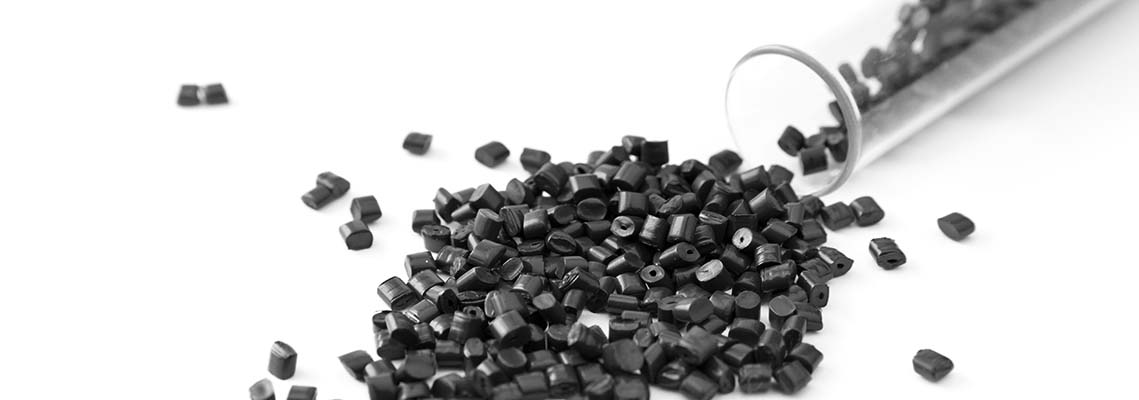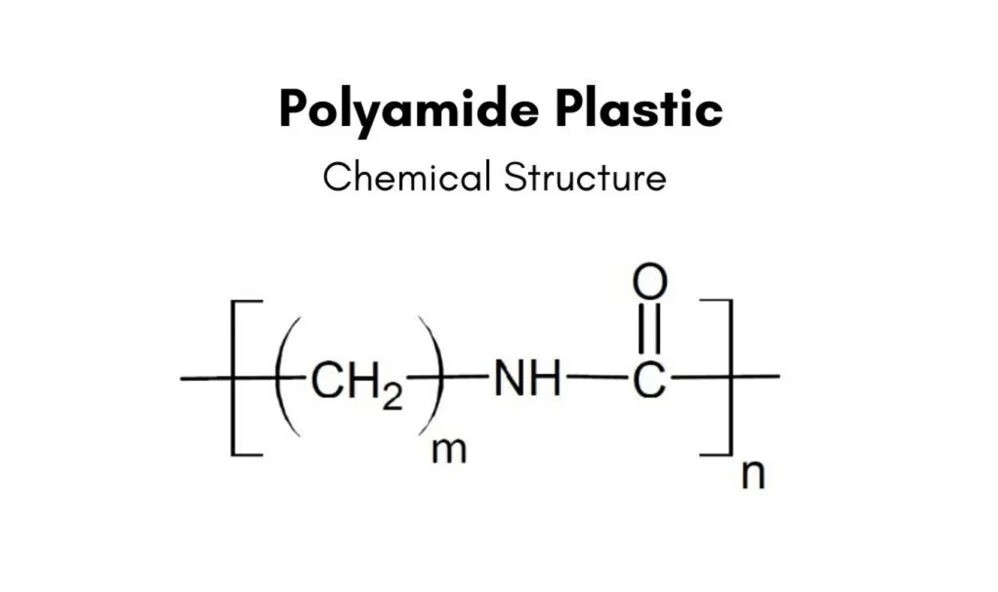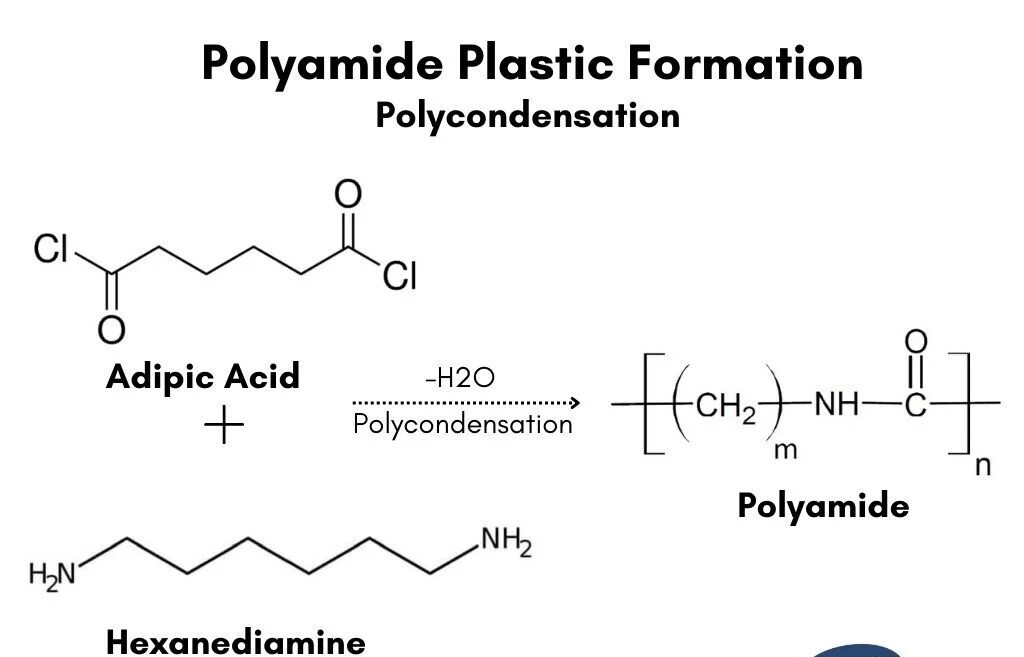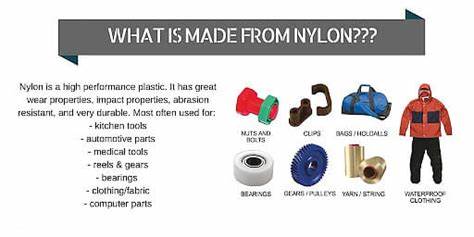Polyamide, commonly known as nylon, is everywhere. From automotive parts to consumer goods, its uses are endless. Discovered by Wallace Carothers, nylon revolutionized materials science. Why is it so widely used? Its impressive wear resistance, lightweight structure, and high thermal stability make it ideal for various industries.
In this post, You'll learn about their diverse types, remarkable properties, and wide-ranging applications. Discover why PA plastics continue to be a game-changer in modern manufacturing.

What is Polyamide (PA) Plastic?
Polyamide (PA) plastic, often called nylon, is a versatile engineering thermoplastic. It's known for its exceptional strength, durability, and resistance to wear and chemicals. To understand the differences between polyamide and nylon, you can refer to our article on the difference between polyamide and nylon.

Chemical Composition and Structure
PA plastics are characterized by repeating amide (-CONH-) linkages in their molecular structure. These linkages form strong hydrogen bonds between polymer chains, giving PA its unique properties.
The basic structure of a polyamide looks like this:
-[NH-CO-R-NH-CO-R'-]-
Here, R and R' represent various organic groups, determining the specific type of PA.
Monomers Used in PA Production
PA plastics are synthesized using different monomers. The most common ones include:
Caprolactam: Used to produce PA 6
Hexamethylenediamine and adipic acid: Used for PA 66
11-aminoundecanoic acid: Used in PA 11 production
Laurolactam: Used to make PA 12
Understanding the PA Numbering System
Ever wondered what those numbers in PA types mean? Let's break it down:
Single number (e.g., PA 6): Indicates the number of carbon atoms in the monomer
Double number (e.g., PA 66): Shows carbon atoms in each of the two monomers used
Synthesis Methods of Polyamide (PA) Plastic
Polyamide (PA) plastics, or nylons, are synthesized through different polymerization methods, each affecting their properties and uses. Two common methods are condensation polymerization and ring-opening polymerization. Let's explore how these processes work.
Condensation Polymerization
This method is like a chemical dance between two partners: diacids and diamines. They react under specific conditions, losing water in the process. The result? Long chains of nylon polymers.

Here's how it works:
Diacids and diamines are mixed in equal parts.
Heat is applied, causing a reaction.
Water molecules are released (dehydration).
Polymer chains form and grow longer.
The reaction continues until the desired chain length is achieved.
A prime example of this method is the production of PA 66. It's made by combining hexamethylenediamine and adipic acid.
Key benefits of condensation polymerization:
Precise control over polymer structure
Ability to create various PA types
Relatively simple process
Ring-Opening Polymerization
This method is like unzipping a molecular circle. It uses cyclic monomers, such as caprolactam, to create PA plastics.

The process involves:
Heating the cyclic monomer (e.g., caprolactam for PA 6).
Adding a catalyst to speed up the reaction.
Breaking open the ring structure.
Connecting the opened rings to form long polymer chains.
Ring-opening polymerization is particularly useful for creating PA 6 and PA 12.
Advantages of this method include:
High purity of the final product
Efficient use of raw materials
Ability to create specialized PA types
Both methods have their unique strengths. The choice depends on the desired PA type and its intended application.
Types of Polyamide (PA) Plastic
Polyamide (PA) plastics come in various types, each offering unique properties based on their molecular structure. These types are mainly classified into aliphatic, semi-aromatic, and aromatic polyamides. Let’s dive into the most common types.
Aliphatic Polyamides
These are the most common PA types. They're known for their versatility and wide range of applications.
PA 6 (Nylon 6)
PA 66 (Nylon 66)
Produced from hexamethylenediamine and adipic acid
Higher melting point than PA 6 (255°C vs 223°C)
Great for high-temperature applications
PA 11 (Nylon 11)
PA 12 (Nylon 12)
PA 6-10 (Nylon 6-10)
PA 4-6 (Nylon 4-6)
Highest melting point among aliphatic polyamides (295°C)
Exceptional thermal and mechanical properties
Often used in high-performance applications
Semi-aromatic Polyamides (Polyphthalamides, PPA)
PPAs bridge the gap between aliphatic and aromatic polyamides. They offer:
Aromatic Polyamides (Aramids)
These high-performance polyamides boast:
Exceptional strength-to-weight ratio
Outstanding heat resistance
Excellent chemical stability
Popular aramids include Kevlar and Nomex.
Here's a quick comparison of key properties:
| PA Type | Melting Point (°C) | Moisture Absorption | Chemical Resistance |
| PA 6 | 223 | High | Good |
| PA 66 | 255 | High | Good |
| PA 11 | 190 | Low | Excellent |
| PA 12 | 178 | Very Low | Excellent |
| PPA | 310+ | Low | Very Good |
| Aramids | 500+ | Very Low | Excellent |
Properties of Polyamide (PA) Plastic
| Property | Aliphatic Polyamides | Semi-aromatic Polyamides | Aromatic Polyamides |
| Wear Resistance | High, especially in PA 66 and PA 6. | Higher than aliphatic PAs. | Excellent in extreme conditions. |
| Thermal Stability | Good, up to 150°C (PA 66). | Better, up to 200°C. | Exceptional, up to 500°C. |
| Strength | Good, can be enhanced with fillers. | Higher than aliphatic PAs. | Extremely high, used in demanding applications. |
| Toughness | Very good, PA 11 and PA 12 are flexible. | Good, more rigid. | Low, unless modified. |
| Impact Strength | High, especially in PA 6 and PA 11. | Good, slightly lower than aliphatic PAs. | Low, unless modified. |
| Friction | Low, excellent for sliding applications. | Very low, ideal for wear environments. | Low, excels under stress. |
| Chemical Resistance | Good, especially in PA 11 and PA 12. | Superior to aliphatic PAs. | Excellent, highly resistant. |
| Moisture Absorption | High in PA 6/66, lower in PA 11/12. | Low, stable in humidity. | Very low, highly resistant. |
| Electrical Insulation | Excellent, widely used. | Good, slightly lower. | Excellent, used in high-performance systems. |
| Mechanical Damping | Good, especially in PA 6 and PA 11. | Moderate, suited for structural uses. | Poor, unless modified. |
| Sliding Properties | Good, especially in PA 6 and PA 66. | Excellent, ideal for moving components. | Exceptional under stress. |
| Heat Resistance | Up to 150°C (PA 66), higher with modifications. | Better, up to 200°C. | Outstanding, up to 500°C. |
| UV Resistance | Low, PA 12 needs modification for outdoor use. | Moderate, better than aliphatic PAs. | Low, needs additives. |
| Flame Retardant | Can be modified for compliance. | Naturally more flame-resistant. | Highly flame-resistant. |
| Dimensional Stability | Prone to moisture absorption, stable in PA 11/12. | Superior, low moisture absorption. | Excellent, highly stable. |
| Abrasion Resistance | High, especially in PA 66 and PA 6. | Better than aliphatic grades. | Exceptional, ideal for high friction. |
| Fatigue Resistance | Good in dynamic applications. | Superior, especially under stress. | High, used in long-term, high-stress uses. |
Modifications to Polyamide
Polyamide (PA) plastics can be modified to enhance their properties for specific applications. Let’s look at some common modifications.
Glass Fiber Reinforcement
Glass fibers are added to improve the strength, stiffness, and dimensional stability of PA plastics. This modification is particularly beneficial in automotive and industrial applications, where increased durability is essential.
| Effect | Benefit |
| Strength | Increased load-bearing capacity |
| Stiffness | Enhanced rigidity |
| Dimensional Stability | Reduced shrinkage and warping |
Carbon Fiber Reinforcement
Adding carbon fibers enhances the mechanical properties and thermal conductivity of polyamides. This is ideal for high-performance parts exposed to mechanical stress or heat, such as aerospace components.
| Effect | Benefit |
| Mechanical Strength | Improved resistance to deformation |
| Thermal Conductivity | Better heat dissipation |
Lubricants
Lubricants reduce friction and improve wear resistance in applications like bearings and gears. By reducing friction, PA plastics can achieve smoother operation and longer part life.
| Effect | Benefit |
| Friction Reduction | Improved wear resistance |
| Smoother Operation | Increased efficiency and part longevity |
UV Stabilizers
UV stabilizers extend the durability of polyamides in outdoor environments by protecting them from ultraviolet degradation. This is essential for outdoor applications like automotive exteriors or outdoor equipment.
| Effect | Benefit |
| UV Resistance | Prolonged outdoor durability |
| Reduced Degradation | Better performance under sunlight exposure |
Flame Retardants
Flame retardants ensure polyamides meet fire safety standards in electrical and automotive sectors. This modification makes PA suitable for use in environments where fire resistance is critical.
| Effect | Benefit |
| Flame Resistance | Safer in high-heat or fire-prone areas |
| Compliance | Meets industry fire safety regulations |
Impact Modifiers
Impact modifiers increase the toughness of polyamides, making them more resistant to cracking under dynamic stress. This modification is especially useful in applications where parts undergo repeated impact, such as in sports equipment or industrial machinery.
| Effect | Benefit |
| Increased Toughness | Better resistance to impact and cracking |
| Durability | Extended life in dynamic environments |
Processing Methods for Polyamide (PA) Plastic
Polyamide (PA) plastic can be processed using various methods, each suited to different applications. Let's explore the main processing techniques.
Injection Molding
Injection molding is widely used for producing PA parts due to its excellent flowability and moldability. The process requires careful control of temperature, drying, and mold conditions.
Temperature: PA 6 requires a melt temperature of 240-270°C, while PA 66 needs 270-300°C.
Drying: Proper drying is crucial to reduce moisture content below 0.2%. Moisture can lead to defects like splay marks and reduce mechanical properties.
Mold Temperature: The ideal mold temperature ranges from 55-80°C, depending on the PA type and part design.
| PA Type | Melt Temperature | Drying Requirement | Mold Temperature |
| PA 6 | 240-270°C | < 0.2% moisture | 55-80°C |
| PA 66 | 270-300°C | < 0.2% moisture | 60-80°C |
For more details on injection molding parameters, you might find our article on process parameters for injection molding service helpful.
Extrusion
Extrusion is another common method for processing PA, especially for creating continuous shapes like tubes, pipes, and films. This method requires specific conditions for highly viscous grades of polyamides. To understand the differences between extrusion and injection molding, you can refer to our comparison of injection blow molding vs extrusion blow molding.
| Parameter | Recommended Setting |
| Screw L/D Ratio | 20-30 |
| PA 6 Processing Temperature | 240-270°C |
| PA 66 Processing Temperature | 270-290°C |
3D Printing
Selective laser sintering (SLS) is a popular 3D printing technique for polyamides. It uses a laser to sinter powdered PA materials layer by layer, creating complex and precise parts. SLS is ideal for prototyping and low-volume production because it eliminates the need for molds. For more information on 3D printing and how it compares to traditional manufacturing methods, check out our article on is 3D printing replacing injection molding.
Benefits: SLS allows the creation of intricate designs, reduces material waste, and is highly flexible for custom shapes.
Applications: Commonly used in automotive, aerospace, and medical industries for rapid prototyping and functional parts.
| 3D Printing Method | Advantages |
| Selective Laser Sintering (SLS) | High precision, no molds required |
For more information on rapid prototyping technologies, you might find our article on what are the characteristics of rapid prototype's manufacturing technology useful.
Physical Forms of Polyamide (PA) Products
Polyamide (PA) products come in various physical forms. Each form has its own unique characteristics and applications. Let's explore the different shapes and sizes of PA:
Pellets
Pellets are the most common form of PA
They are small, cylindrical, or disc-shaped pieces
Pellets typically measure 2-5mm in diameter
They are primarily used for injection molding processes
Powders
PA powders have a fine particle size, ranging from 10-200 microns
They are used in various applications, such as:
Granules
Granules are slightly larger than pellets
They measure 4-8mm in diameter
Granules are easier to feed into extrusion machinery compared to powders
They improve material flowability during processing
Solid Shapes
PA can be machined into various solid shapes
Common forms include rods, plates, and custom-designed parts
These shapes are created from PA stock materials
They offer versatility for specific applications and designs
| Form | Size | Applications |
| Pellets | 2-5mm diameter | Injection molding |
| Powders | 10-200 microns | Rotational molding, powder coating, SLS 3D printing |
| Granules | 4-8mm diameter | Extrusion processes |
| Solids | Various custom shapes | Machined components and specialized designs |
Applications of Polyamide (PA) Plastic
Polyamide (PA) plastic is versatile, making it essential across various industries. Its strength, chemical resistance, and durability provide benefits in many demanding environments.

Automotive Industry
In the automotive sector, polyamides are used for several critical components. Engine parts, fuel systems, and electrical insulators rely on PA plastic due to its heat resistance, strength, and durability.
| Application | Key Benefits |
| Engine Components | Heat resistance, strength |
| Fuel Systems | Chemical resistance, low permeability |
| Electrical Insulators | Electrical insulation, heat stability |
Industrial Applications
Industrial settings take advantage of polyamide’s wear resistance and low friction properties. Bearings, gears, valves, and seals made from PA are durable, reduce friction, and perform well in high-stress environments.
| Application | Key Benefits |
| Bearings and Gears | Wear resistance, low friction |
| Valves and Seals | Chemical and mechanical resistance |
Consumer Goods
From sports equipment to everyday household items, polyamide is widely used for its toughness and flexibility. Items like tennis rackets and kitchen utensils benefit from PA’s durability and ease of processing.
| Application | Key Benefits |
| Sporting Equipment | Toughness, flexibility |
| Household Items | Durability, ease of molding |
Electrical and Electronics
In electronics, polyamides are valued for their electrical insulation properties. They are used in connectors, switches, and enclosures where insulation and heat resistance are crucial.
| Application | Key Benefits |
| Connectors and Switches | Electrical insulation, heat resistance |
| Enclosures | Strength, chemical resistance |
Food Industry
Food-grade polyamides are safe for direct contact with food and are used in packaging, conveyor belts, and machinery parts. These materials offer excellent chemical resistance and low moisture absorption.
| Application | Key Benefits |
| Food-Grade Packaging | Chemical resistance, safe for contact |
| Conveyor Belts | Durability, moisture resistance |
Comparison of Polyamide (PA) Plastic with Other Materials
Polyamide (PA) plastic stands out for its unique combination of strength, flexibility, and chemical resistance. Here’s how it compares to other common materials.
PA Plastic vs. Polyester
Polyamide and polyester are both synthetic polymers, but they have key differences. PA offers better strength and impact resistance, while polyester is more resistant to stretching and shrinking. PA also absorbs more moisture than polyester, which affects its dimensional stability in humid environments.
| Property | Polyamide (PA) | Polyester |
| Strength | Higher | Moderate |
| Impact Resistance | Excellent | Lower |
| Moisture Absorption | High | Low |
| Stretch Resistance | Lower | Higher |
PA Plastic vs. Polypropylene (PP)
PA has better mechanical properties compared to polypropylene (PP), such as higher strength and wear resistance. However, PP has superior chemical resistance, especially against acids and alkalis. PA is more heat-resistant, while PP is known for its flexibility and lighter weight.
| Property | Polyamide (PA) | Polypropylene (PP) |
| Strength | Higher | Lower |
| Chemical Resistance | Good, but weak against acids | Excellent |
| Heat Resistance | Higher | Lower |
| Flexibility | Lower | Higher |
PA Plastic vs. Polyethylene (PE)
Polyamide offers much higher strength and heat resistance compared to polyethylene (PE). PE is more flexible and has better moisture resistance, making it ideal for packaging materials. PA, on the other hand, excels in applications requiring mechanical durability and heat resistance. To understand the differences between types of PE, you can refer to our article on differences between HDPE and LDPE.
| Property | Polyamide (PA) | Polyethylene (PE) |
| Strength | Higher | Lower |
| Heat Resistance | Higher | Lower |
| Flexibility | Lower | Higher |
| Moisture Resistance | Lower | Excellent |
PA Plastic vs. Metals (Aluminum, Steel)
While metals like aluminum and steel are much stronger, PA plastic is much lighter and easier to process. PA is corrosion-resistant and doesn’t require the same maintenance as metals in corrosive environments. Metals are better suited for applications requiring extreme strength and load-bearing capacity, while PA excels in reducing weight and increasing flexibility. For a comparison between different metals, you might find our article on titanium vs aluminum interesting.
| Property | Polyamide (PA) | Aluminum | Steel |
| Strength | Lower | High | Very High |
| Weight | Low (lightweight) | Moderate | High |
| Corrosion Resistance | Excellent | Good | Poor |
| Flexibility | Higher | Lower | Lower |
For more information on metal materials and their properties, you can check our guide on different types of metals.
Conclusion
Polyamide (PA) plastics are versatile, offering strength, heat resistance, and durability. These qualities make them essential in modern engineering and manufacturing. Whether used in automotive, electronics, or industrial applications, PA plastics provide reliable performance.
When selecting a PA type, consider the specific requirements like strength, flexibility, and environmental resistance. Each PA grade offers unique benefits for different applications, ensuring the right material for the job.
Tips: You maybe interested to the all plastics














